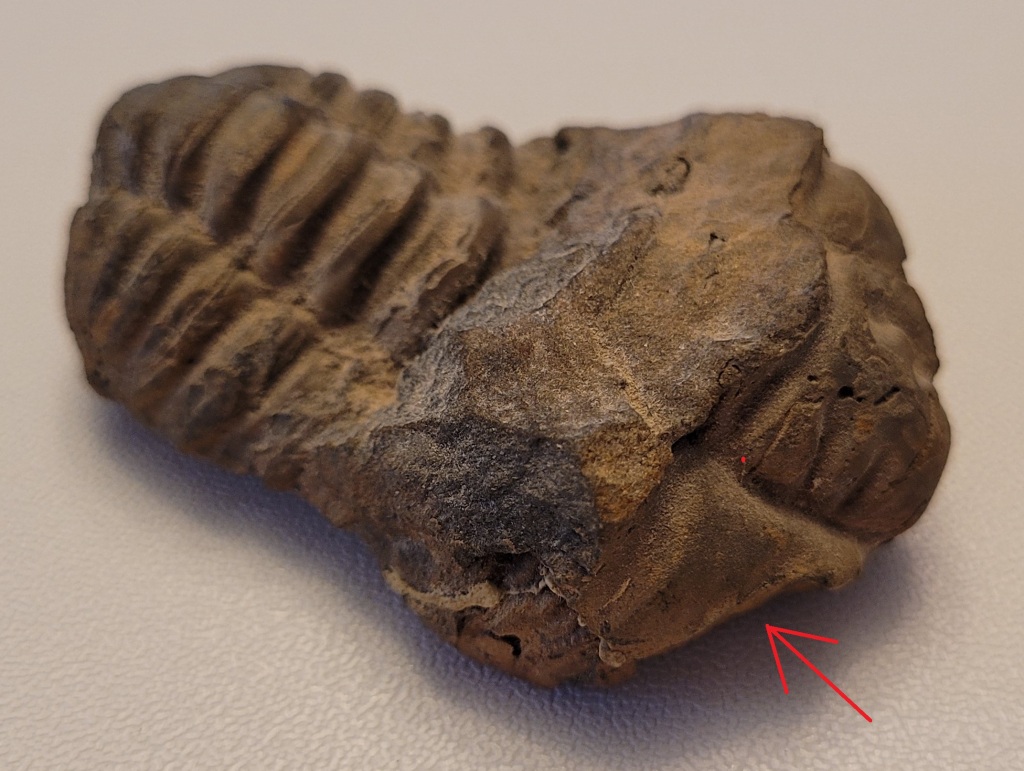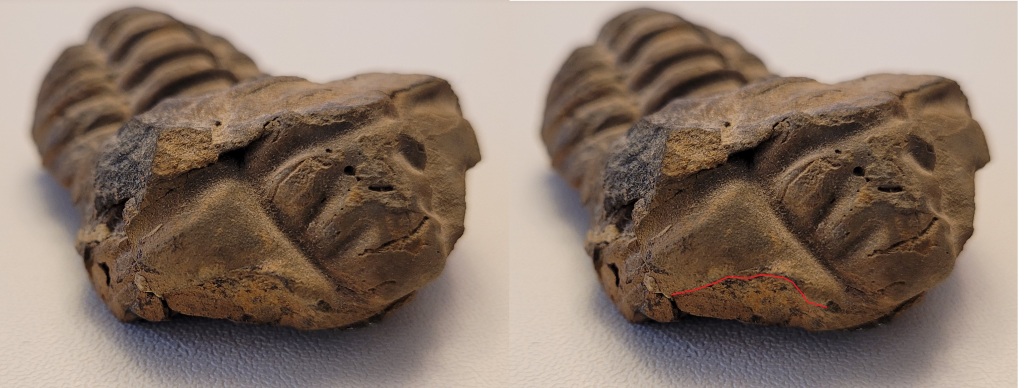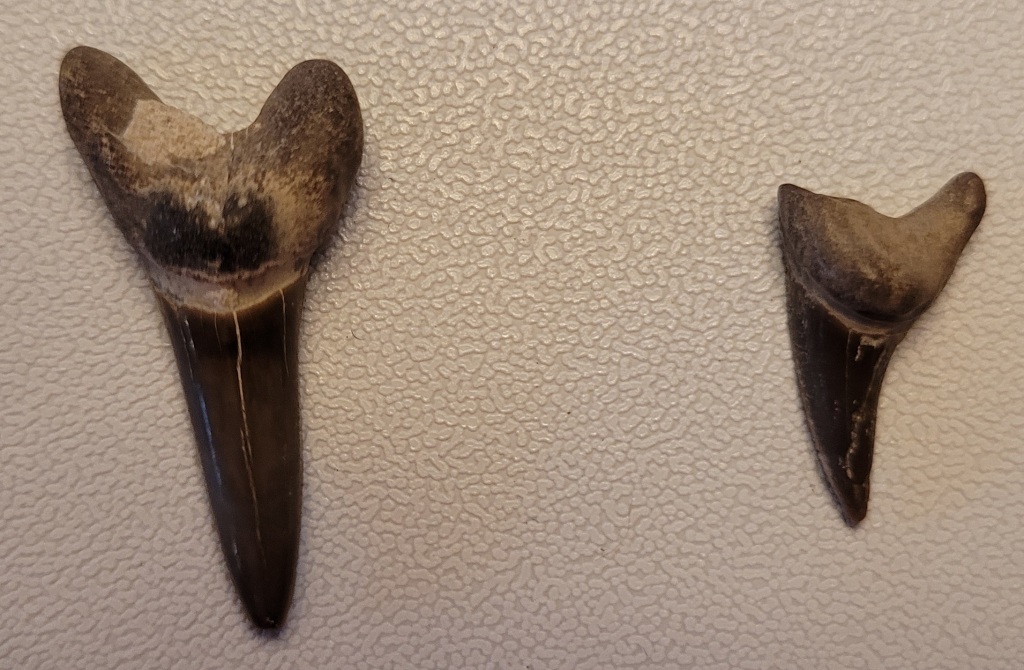
How many fossils can one creature create? At a glance, it seems like the answer is: one. After all, one creature gets buried, dies, and gets fossilized, creating one fossil. One organism leads to one fossil.
However, it does not always work that way. Take footprints, for instance. An animal can walk across some soft sediment, creating prints, and then walk off somewhere else, creating more tracks or even becoming buried and producing a fossil of its body. We know that this can happen since such fossils have actually been found. For example, a horseshoe crab trackway has been found with the body of the animal preserved at its end.[1] In this case, we know for sure that the horsehoe crab created two fossils: the trackway and the body at the end of the trackway.
But surely a single animal can only produce a single body fossil, right? Note that the term “body fossil” specifically refers to a fossil that preserves the body of the animal. Body fossils are contrasted with trace fossils, which are tracks or traces left behind by an animal. Note that, in the case of the horseshoe crab, one animal produced two fossils, but one was a trace fossil (the trackway) and the other was a body fossil (the horsehoe crab at the end of the trackway). If we ignore the trace fossils, one body produces one body fossil, right?
Again, not always. Large fossils, such as a large plants, can get broken apart, and the various parts can be fossilized separately. At times, those different parts can be distinctive enough that they are given separate names. For example, the name Stigmaria is applied to the roots of a plant in the order Lepidodendrales, while the stems of the same plant often go by a different name, such as Lepidodendron.[2] The reason they have been given different names is because when they were discovered, paleontologists thought they belonged to different types of plants. It was only later when they found out that the roots (Stigmaria) belonged to the stem (Lepidodendron). This example just goes to show that the body of one organism can still produce two fossils, if the body gets broken up.
A single creature producing body and trace fossils makes sense. A single creature having different parts that fossilize separately also makes sense. But there are also cases where an animal can shed part or all of its body, the animal can go on living, and the shed part gets fossilized. In this way, a single animals can produce several body fossils.
Here are two examples of a single animal shedding part of itself. The first is a trilobite. Trilobites are common fossils and they represent an entire extinct group of arthropods. Arthropods of all types, be they insects, crustaceans, or arachnids, have to periodically shed their exoskeleton in order to grow. This process is called molting. Trilobites were no exception. In fact, the fossil seen in the picture below is the molt of a trilobite, not the body of a trilobite that recently died. How do I know this? Notice that the cheek region of the trilobite is missing. These cheek regions were shed, opening up the face of the trilobite, and then the trilobite crawled out, leaving its molt behind. The trilobite could then crawl off, continue living, leaving more molts behind to become fossilized.


Granted, the molt would not last very long: it would break up and disintegrate over a short time. As most fossils were created during Noah’s Flood, it is not likely that the trilobite that produced this molt survived much longer after shedding it. The Flood probably happened in a matter of days after the trilobite molted. Still, the trilobite could have been buried by the Flood along with its molt, producing two body fossils.
As an aside, note that, in at least some cases, fossils produced by the Flood do not preserve animals that were buried rapidly while alive. Sure, there are several fossils that appear to be like this: dinosaurs caught in the act of fighting, a fish preserved in the act of swallowing its food, and so forth. We like to focus on these examples and as such, may get the impression that they represent the majority of fossils. In fact, most fossils were much more mundane. It appears that the most frequently discovered fossils of trilobites are their molts.[3] We seen an abundance of shed trilobite exoskeletons, not an abundance of trilobites buried while fleeing for their lives from a deluge. Rapid burial of living creatures did happen, but there was also a large number of dead things buried, as well.
Another example of an animal that sheds part of its body are sharks. Sharks are famous for constantly shedding their teeth. These shed teeth can fall to the sea floor and, if the conditions are right (such as, the Flood is about to occur), can get preserved and fossilized. This is part of the reason shark teeth are found so frequently: most of them probably represent shed teeth that accumulated on the sea floor before the Flood occurred.

The study of fossils can be quite fascinating. We often think of a fossil as the body of an organism, but fossils can also be traces left behind by organisms, and they can also be shed parts of an animal’s body. Such a diversity makes fossils interesting, and at times, difficult, to study.
Thoughts from Steven
[1]Prostak, Sergio (2012) “Stunning Discovery: World’s Longest Fossilized ‘Death Track'” sci.news, retrieved from https://www.sci.news/paleontology/article00554.html on June 16, 2024
[2]Horenstein, Sidney, ed. (1986) Simon & Schuster’s Guide to Fossils, Simon & Schuster, New York, New York, pg. 50-52
[3]Prothero, Donald (2004) Bringing Fossils to Life: An Introduction to Paleobiology, 2nd. Ed., McGraw Hill, Boston, Massachusetts, pg. 257